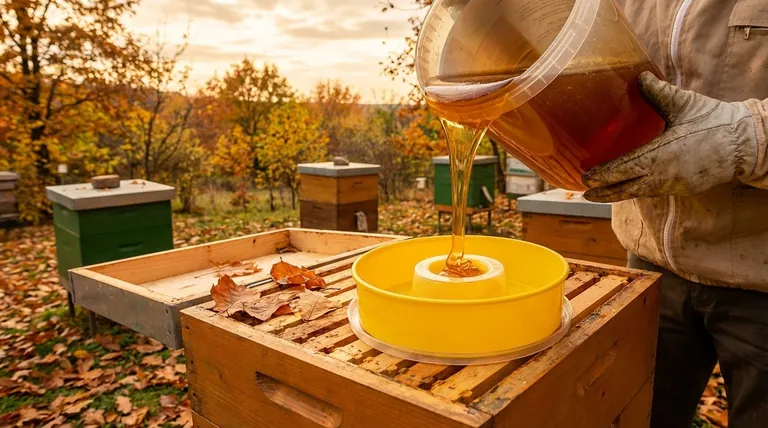For autumnal feeding, the recommended mix is a heavy syrup with a 2:1 ratio of sugar to water by weight. This is specifically designed to help honey bees build up their winter food stores. The most common recipes are 2 pounds of sugar dissolved into 1 pint of water, or 1 kilogram of sugar dissolved into 625 milliliters of water.
The goal of autumn feeding is fundamentally different from spring feeding. You are not trying to stimulate the colony's growth; you are providing dense, easily-stored calories to ensure the hive has enough food to survive the winter.

Why a Heavy Syrup is Essential for Autumn
The ratio of your syrup sends a clear signal to the colony. In autumn, you want that signal to be "winter is coming, store this food immediately."
The Goal: Building Winter Stores
A heavy 2:1 syrup has a high sugar concentration, which is less work for the bees to process. They do not need to expend as much energy fanning their wings to dehydrate the liquid and convert it into capped honey for winter.
Mimicking a Late-Season Nectar Flow
This dense syrup closely resembles a rich, late-season nectar flow. It encourages the bees to take the syrup down quickly and place it directly into storage cells in the brood box.
The Correct Ratio (2:1)
To be precise, the recommended mix is 2 parts sugar to 1 part water by weight.
- Imperial: 2 pounds of white granulated sugar per 1 pint (16 fl oz) of water.
- Metric: 1 kilogram of white granulated sugar per 625 milliliters of water.
Hot water will help the sugar dissolve, but do not boil the syrup, as this can create compounds harmful to bees.
The Critical Difference: Autumn vs. Spring Feeding
Using the wrong syrup at the wrong time of year can be detrimental to the colony. The purpose of feeding changes dramatically with the seasons.
Autumn Feeding (Heavy 2:1 Syrup)
The primary purpose is energy storage. A heavy syrup discourages the queen from laying more eggs because the bees are focused on filling available cells with food. This is desirable as you want the colony to reduce brood rearing and focus on winter preparations.
Spring Feeding (Light 1:1 Syrup)
The goal of spring feeding is stimulation. A light, 1:1 syrup (1 part sugar to 1 part water) mimics the first nectar flows of the new season. This encourages the queen to start laying eggs, helping to rapidly build up the colony's population to prepare for the main summer honey flow.
Understanding the Pitfalls and Trade-offs
Making the right choice in autumn feeding is about more than just the ratio; it's about timing and understanding bee biology.
The Mistake of Using Light Syrup in Autumn
Feeding a 1:1 "stimulative" syrup in the fall can confuse the colony. It may trigger the queen to lay more eggs, resulting in a late-season brood that consumes the very stores you are trying to build. This puts the colony at high risk of starvation over the winter.
The Importance of Timing
Autumn feeding is not a last-minute task. This feeding should be completed by the end of September or early October, depending on your climate. The bees need sufficient time and warm enough temperatures (above 50°F / 10°C) to take the syrup, process it, and cap it before cold weather sets in.
Unprocessed Syrup is a Hazard
If you feed too late, the bees cannot dehydrate the syrup properly. This uncapped "honey" has high moisture content and can ferment in the hive, leading to dysentery and other diseases during the cold winter months when bees cannot take cleansing flights.
Making the Right Choice for Your Goal
Always match your feeding strategy to the specific outcome you want to achieve for your colony.
- If your primary focus is building winter stores for survival: Use a heavy 2:1 syrup (2 parts sugar to 1 part water by weight) in early autumn.
- If your primary focus is stimulating brood production in spring: Use a light 1:1 syrup (1 part sugar to 1 part water by weight) to mimic an early nectar flow.
- If your primary focus is emergency feeding or drawing comb mid-season: Use an intermediate syrup (roughly 1kg sugar to 1L water) as a versatile, all-purpose solution.
Matching your syrup ratio to the season is one of the most effective ways to support your colony's natural cycle and ensure its long-term health.
Summary Table:
| Feeding Goal | Recommended Syrup Ratio (Sugar:Water) | Primary Purpose |
|---|---|---|
| Autumn Feeding (Winter Stores) | 2:1 by weight | Energy storage, discourages brood rearing |
| Spring Feeding (Colony Buildup) | 1:1 by weight | Stimulate brood production |
| Emergency/Mid-season Feeding | ~1kg sugar to 1L water | Versatile, all-purpose solution |
Ensure your commercial apiary is prepared for winter with the right supplies. HONESTBEE provides the high-quality feeding equipment and essential beekeeping supplies that distributors and large-scale operations rely on for efficient, effective autumn feeding. Let us help you secure your colonies' health and productivity. Contact our wholesale team today to discuss your needs.
Visual Guide

Related Products
- HONESTBEE Round Hive Top Bee Feeder for Syrup
- Classic Boardman Entrance Bee Feeder Hive Front Feeding Solution
- HONESTBEE Entrance Bee Feeder Professional Hive Nutrition Solution for Beekeeping
- Rapid Bee Feeder White Plastic 2L Round Top Feeder for 8 or 10-Frame Bee Hives
- Professional Hive Top Bee Feeder for Beekeeping
People Also Ask
- What types of hive boxes is the round hive top feeder compatible with? Universal Fit for 8 & 10-Frame Langstroth Hives
- How do hive top feeders work? A Guide to Efficient, High-Capacity Bee Feeding
- Why is a top feeder essential for bees? Ensure Colony Health and Efficiency
- What can the round hive top feeder be used for? A Guide to Efficient, Safe Bee Feeding
- How should syrup for bees be prepared? Master the Ratio for a Thriving Hive



















